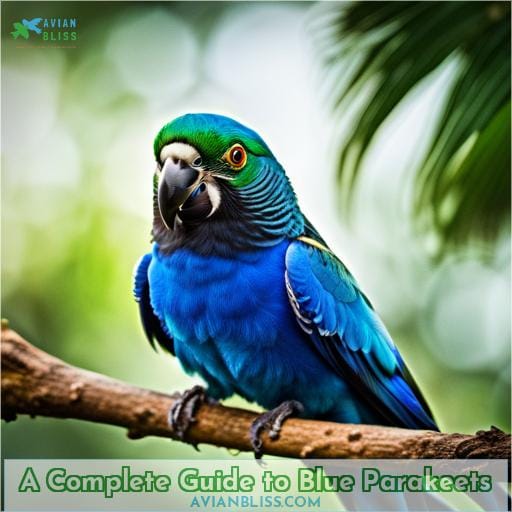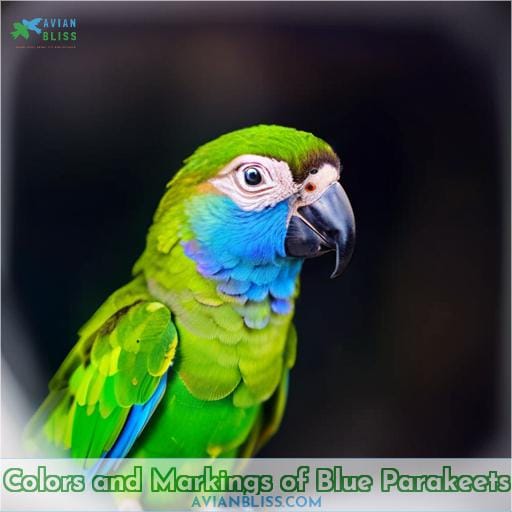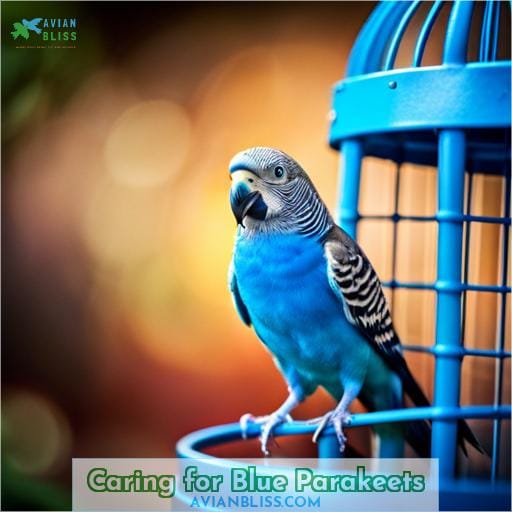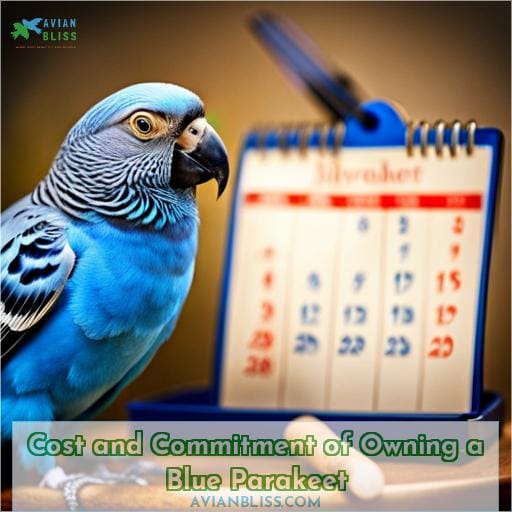This site is supported by our readers. We may earn a commission, at no cost to you, if you purchase through links.

In this complete guide to blue parakeets, discover everything you need to know before bringing one into your life. From unraveling their origin story and exploring their unique temperament to understanding their vocalizations and caring for them with love, this guide will equip you with all the essential knowledge for a joyful journey with these delightful feathered companions.
Let’s embark on an enchanting adventure together!
Table Of Contents
- Key Takeaways
- Understanding the Origin and History of Blue Parakeets
- Exploring the Temperament of Blue Parakeets
- Speech and Vocalizations of Blue Parakeets
- Colors and Markings of Blue Parakeets
- Caring for Blue Parakeets
- Where to Adopt or Buy a Blue Parakeet
- Considerations for Similar Species
- Importance of Enrichment and Mental Stimulation
- Cost and Commitment of Owning a Blue Parakeet
- Frequently Asked Questions (FAQs)
- Conclusion
Key Takeaways
- Blue parakeets are native to Australia but popular pets worldwide that come in a variety of colors.
- Caring for blue parakeets requires providing a large cage, a balanced diet, and regular veterinary care.
- Blue parakeets are playful, affectionate birds that need a lot of interaction and can mimic speech.
- Blue parakeets can be trained to perform tricks but require patience and consistent training when young.
Understanding the Origin and History of Blue Parakeets
Blue parakeets have a fascinating origin and history that traces back to their native land of Australia.
These captivating birds, scientifically known as Melopsittacus undulatus, were first introduced to Europe by the renowned naturalist John Gould in the mid-19th century. However, breeding restrictions imposed in 1894 led to an exponential growth of the European breeding business for these charming creatures.
In America, blue parakeets arrived around 1920 and quickly gained popularity during the 1950s. It’s important to note that there are two common types of blue parakeets: American budgies commonly found in pet stores and English budgies typically seen at exhibitions.
One notable challenge faced by blue parakeet owners is speech mimicry. While they’re capable of mimicking human speech, teaching them can be quite challenging due to their tendency to bond more with each other than with their owners.
Selective breeding has also had a significant impact on these delightful avian companions, resulting in a wide range of colors beyond their natural wild coloration such as violet and yellow variations.
Exploring the Temperament of Blue Parakeets
After learning about their origin and history, let’s dive into the temperament of blue parakeets.
Blue parakeets are playful companions that thrive on social bonding with their owners. They’ve a natural inclination for vocal mimicry, making them fascinating pets to interact with. Training techniques can be employed to enhance this ability and create a deeper connection between you and your feathered friend.
However, it’s important to note that they may present behavioral challenges along the way due to their independent nature. To ensure the well-being of your blue parakeet, it’s crucial to provide proper diet and exercise opportunities while being vigilant for any signs of illness or distress in order to address them promptly.
- Playful Companionship
- Social Bonding
- Vocal Mimicry
- Training Techniques
Speech and Vocalizations of Blue Parakeets
One important aspect of blue parakeets is their ability to mimic speech and vocalize in various ways.
These charming birds possess incredible mimicry mastery, often surprising their owners with the accuracy of sounds they imitate.
Blue parakeets showcase a wide range of vocal variety, from whistles and chirps to melodic tunes that can brighten any room.
Their communicative capabilities extend beyond sound imitation as they use vocalizations to express emotions, attract attention, and establish social bonds within their flock or human family.
While some blue parakeets may face speech challenges due to individual differences in learning abilities or environmental factors, providing them with ample attention and mental stimulation can enhance their speech development.
It’s important for owners to understand the importance of maintaining a healthy environment that promotes both physical health and cognitive well-being for these delightful companions.
Colors and Markings of Blue Parakeets
When it comes to the colors and markings of your blue parakeet, you’ll be amazed by the vibrant hues and unique patterns they can display.
Blue parakeets exhibit a wide range of visual characteristics due to genetic variations and selective breeding practices. Breeders have successfully created different color morphologies, including shades of violet, yellow, pied, albino, neon green in addition to their natural light green with black bars.
These beautiful variations make each blue parakeet truly one-of-a-kind. Whether you’re a bird enthusiast or simply looking for an exquisite pet bird companion, the stunning colors and markings of blue parakeets will surely captivate your heart.
Caring for Blue Parakeets
To properly care for blue parakeets, it’s crucial to provide them with suitable living conditions that include:
- A spacious cage
- Appropriate temperatures
Ensuring a balanced diet and nutrition is also vital, with seeds being only a portion of their daily intake.
Additionally, addressing common health issues through regular veterinary check-ups and promoting exercise and physical activity will contribute to the overall well-being of your blue parakeet companions.
Providing Proper Living Conditions
To ensure the well-being of your blue parakeet, provide proper living conditions:
- Choose a cage with minimum dimensions to allow for exercise and movement.
- Place the cage away from drafts to maintain a stable temperature.
- Clean the cage daily and change water regularly to promote hygiene.
- Provide toys with varied textures and colors for mental stimulation.
- Use natural wood perches to support foot health.
Ensuring a Balanced Diet and Nutrition
To ensure the optimal health and well-being of your blue parakeet, provide them with a balanced diet.
Include seeds, fruits, and vegetables while ensuring fresh water daily.
Monitor changes in appetite, feces, and behavior for any signs of health issues.
Addressing Common Health Issues
You’ll need to watch out for some common health issues that blue parakeets are prone to, like nutritional deficiencies resulting in goiters and tumors, bacterial infections, mites, and more.
Carrying on from proper diet and nutrition, recognizing and addressing potential health problems is key for your blue parakeet’s wellbeing. Regular veterinary examinations help detect issues early, while providing a balanced diet fortified with iodine prevents goiter development.
Promoting Exercise and Physical Activity
Allow about 2 hours of daily free flight in a secure area since physical activity and exercise are essential.
Rotate their cage toys frequently and incorporate platforms, ladders, and toys with various textures to keep them active.
Regular veterinary check-ups support their health.
Where to Adopt or Buy a Blue Parakeet
Your best bet for adopting or purchasing a blue parakeet is connecting with reputable breeders and bird rescues who can educate you on the birds’ histories and care.
While pet stores may seem convenient, be cautious of potential underlying health or behavioral issues in birds from mass-breeding operations.
Vet any online retailers thoroughly and ask for health guarantees and return policies.
The most ethical sources are responsible breeders who raise birds in enriching environments, and rescues/shelters with healthy, socialized birds and full transparency.
Develop relationships with avian specialists to find the right blue parakeet for you.
Choosing a hand-fed baby from a breeder or adopting a rescue bird both offer rewards if done carefully – enriching your life with these gentle, vocal companions.
Considerations for Similar Species
When considering a blue parakeet as a pet, it’s important to explore other similar species before making your final decision.
Comparing the characteristics and care requirements of lovebirds, cockatiels, conures, and parrotlets can help you choose the right parrot that aligns with your preferences and lifestyle.
Additionally, evaluating their size, temperament, lifespan, and compatibility with other household pets will ensure a harmonious environment for both you and your feathered friend.
Similar Species Comparison
When considering owning a Blue Parakeet, it’s important to compare them to similar species like conures, cockatiels, and lovebirds.
Consider their personality, size, lifespan,
care requirements (diet and exercise), compatibility with other pets,
vocalizations, intelligence level.
Also factor in cost considerations and availability for adoption or purchase.
Choosing the Right Parrot
Consider other small parrots when choosing the right companion for your blue parakeet.
Explore options like lovebirds, cockatiels, conures, and parrotlets.
Evaluate their size, personality, compatibility with other pets, and lifespan to find the perfect match for your blue parakeet’s age, hand rearing, training, taming, maintenance, and cost considerations.
Compatibility with Other Pets
Now let’s talk about how blue parakeets can coexist with other pets in your household.
When considering compatibility, it’s important to assess the temperament and needs of both the blue parakeet and any potential companions such as canaries, finches, doves, cockatiels, or lovebirds.
Proper introductions and gradual interactions are key to ensuring a harmonious environment for all your feathered friends.
Importance of Enrichment and Mental Stimulation
To ensure the overall well-being and happiness of your blue parakeet, it’s essential to understand the importance of providing enrichment and mental stimulation. Blue parakeets are intelligent birds that require regular interaction, attention, and engaging activities to prevent boredom and behavioral issues.
Here are some key reasons why enrichment is vital for your feathered friend:
- Toys: Providing a variety of toys promotes mental stimulation while preventing boredom.
- Interaction: Regular human interaction helps establish trust and strengthens the bond between you and your bird.
- Exercise: Engaging in physical activity through playtime outside the cage or with interactive toys ensures a healthy lifestyle.
- Mental Stimulation: Offering puzzles or foraging opportunities keeps their minds active, preventing dullness.
Remember to rotate toys regularly to maintain interest, provide different textures for chewing pleasure,and offer a diverse dietfor added variety in their daily routine.
Cost and Commitment of Owning a Blue Parakeet
When owning a Blue Parakeet, it’s important to understand the cost and long-term commitment involved.
The average cost of a Blue Parakeet ranges from $10 to $60, depending on factors such as age and health.
These beautiful birds have an impressive lifespan of 15 to 20 years, meaning you’ll be responsible for their care for many years to come.
Providing a balanced diet consisting of seeds, fruits, and vegetables is crucial for their overall health and well-being. Additionally, ensuring they’ve suitable living conditions in a spacious cage with a roosting box promotes their physical comfort and mental stimulation needs.
Don’t forget about toys! They play an essential role in providing mental stimulation and exercise opportunities for your feathery friend.
Frequently Asked Questions (FAQs)
Can blue parakeets live with other bird species?
Blue parakeets can live harmoniously with other bird species, such as finches or budgies, as long as their needs and temperaments are compatible.
Introducing them gradually and providing adequate space is crucial for successful cohabitation.
How do blue parakeets communicate with each other?
Blue parakeets, with their melodious calls and graceful dances, communicate through a symphony of chirps and body language.
Their vibrant feathers shimmer like a secret code, conveying messages of love, warning, and camaraderie to their avian companions.
Are there any health issues specific to blue parakeets?
Blue parakeets, like any other pet birds, may be susceptible to common health issues such as:
- Respiratory infections
- Nutritional deficiencies
Regular veterinary check-ups are crucial for early detection and proper care.
Can blue parakeets be trained to perform tricks?
Blue parakeets can indeed be trained to perform tricks, just like a skilled acrobat soaring through the air.
What are some common misconceptions about blue parakeets?
Common misconceptions about blue parakeets include:
- Their inability to be trained, when in fact they can learn tricks with positive reinforcement.
- That they’re low-maintenance pets, but they require proper care and attention for their well-being.
Conclusion
Embark on an enchanting adventure with blue parakeets, the captivating feathered companions that steal hearts with their vibrant beauty and charming personalities. This complete guide equips you with essential knowledge before bringing one into your life.
From understanding their origin and exploring their unique temperament to caring for their physical and mental well-being, you’ll be prepared for a joyful journey. Discover where to adopt or buy a blue parakeet and consider the importance of enrichment and mental stimulation.
Get ready for a fulfilling and rewarding experience with these delightful birds.












